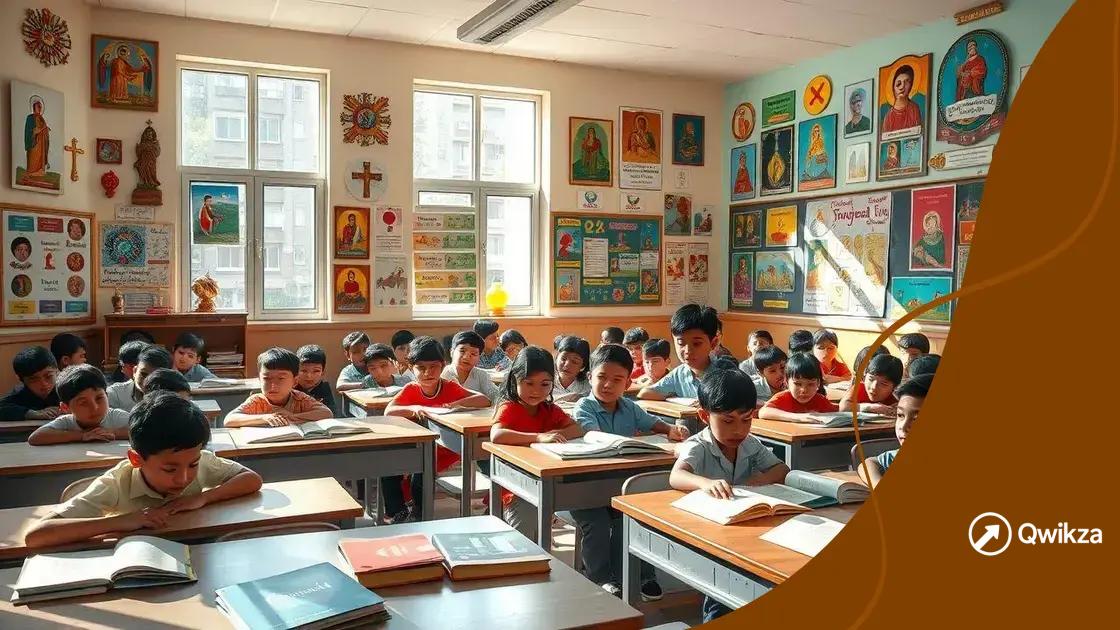Debate over religious symbols in schools: a closer look

The debate over religious symbols in schools centers on balancing students’ rights to express their beliefs with the need for inclusivity and the legal framework ensuring separation of church and state.
The debate over religious symbols in schools often sparks intense discussions about freedom, respect, and inclusion. How should educational institutions navigate these complex issues? Let’s dive into the various viewpoints and consequences.
Historical context of religious symbols in education
The historical context of religious symbols in education is rich and complex. Schools have always mirrored the cultures and beliefs of the societies they serve. Understanding this context helps us see why these symbols have become points of contention.
In ancient times, rituals and symbols were integral to education. For instance, in medieval Europe, churches operated many schools, which often taught religious doctrine alongside basic literacy. This blending of education and religion laid the foundation for modern schooling.
Transition to Religious Neutrality
As societies evolved, so did the perspectives on religion in public education. The Enlightenment brought forward ideas of reason and secularism. Consequently, many schools in the 19th and 20th centuries aimed for a neutral stance on religion.
- Public schools began adopting policies to separate state and religion.
- Legal cases, like Engel v. Vitale in 1962, reinforced this separation.
- Religious symbols were removed from classrooms to promote inclusivity.
Despite these trends, some still advocate for the presence of religious symbols in schools, arguing it fosters a sense of community and cultural heritage. This tension between inclusion and tradition reflects broader social debates.
Recent Developments
In recent years, discussions surrounding religious symbols have resurged. Schools faced cases where students wanted to express their religious beliefs through symbols, leading to questions of rights and identity. Many believe that encouraging such expression can enhance understanding among diverse groups.
- Students express their beliefs through vestments, jewelry, or classroom displays.
- Recent rulings have ruled in favor of student expression in some cases.
- Advocates push for policies that respect all beliefs.
The dialogue continues as society grapples with these complex issues. It’s essential to listen to various voices in this ongoing conversation, as the landscape of religious symbols in education is continually changing, reflecting the views and values of a diverse community.
Legal battles over religious representation
The legal battles over religious representation in schools highlight a critical aspect of the ongoing debate about religious symbols. Throughout history, courts have played a crucial role in determining how religious beliefs intersect with public education.
One significant case in this arena was Engel v. Vitale, decided in 1962. This case resulted in a landmark ruling that banned school-sponsored prayer. The decision emphasized that even voluntary prayers led by school officials could be seen as endorsements of religion, thus violating the First Amendment.
Subsequent Legal Cases
Following Engel, several other notable legal cases made headlines. One important case was Lemon v. Kurtzman, which established the Lemon Test. This test assesses whether a law or government action supports religion in a way that breaches the separation of church and state.
- It focuses on whether the action has a secular purpose.
- It examines if it advances or inhibits religion.
- It checks if it fosters excessive government entanglement with religion.
These criteria guide ongoing debates about how religious symbols and practices fit into public education. Additionally, students’ rights have been protected through cases such as Mergens v. Westminster, which upheld students’ rights to create religious clubs in schools.
Current Trends and Challenges
As society evolves, new challenges arise. Recent cases have sought to clarify how religious representation can coexist with a secular educational agenda. For instance, discussions surrounding the display of religious symbols during school events have gained traction. Balancing freedom of expression and respect for diverse beliefs remains a tightrope that schools must navigate.
Advocates for religious representation argue it promotes cultural awareness, while others caution against potential exclusion of non-religious students. These tensions illustrate the complexities schools face in acknowledging all voices while adhering to legal standards.
Cultural diversity and its impact in schools

Cultural diversity has a profound impact on schools, shaping not only the curriculum but also the social dynamics among students and staff. As classrooms become more diverse, the need for inclusive practices and policies grows.
Schools that embrace cultural diversity can create a nurturing environment where students feel valued and respected. This inclusion leads to enhanced academic performance, as students are more engaged when their backgrounds are acknowledged.
The Benefits of Cultural Diversity
Recognizing and celebrating different cultures positively influences the school community. Here are key benefits:
- Improved creativity and innovation in problem-solving.
- Broader perspectives in discussions, enriching learning experiences.
- Preparation of students for a globalized society.
- Enhanced social skills as students learn to navigate diversity.
With these benefits, schools are motivated to develop programs that promote awareness and understanding among students. This can include cultural events, language classes, and discussions that reflect the diversity of their student body.
Challenges Faced
Despite the many advantages, schools face challenges when integrating cultural diversity. Misunderstandings can arise from differing cultural norms, leading to friction among students. Teachers must navigate these complexities sensitively to foster a respectful atmosphere. To address this, training for educators on cultural competency is essential.
Moreover, some students may feel excluded if their cultures are not represented in the curriculum. This can hinder their sense of belonging. Schools must strive to include a variety of cultural perspectives in lesson plans to combat this issue.
Building a truly inclusive school environment requires ongoing effort. By embracing cultural diversity, schools not only enhance the educational experience but also prepare students for a more interconnected world.
Perspectives from students and educators
Perspectives from students and educators provide valuable insights into the ongoing debate about religious symbols in schools. Both groups play essential roles in shaping the school culture and addressing the complexities of this topic.
Students often feel strongly about their right to express their beliefs. For many, displaying religious symbols is an integral part of their identity. They may argue that schools should allow them to wear symbols like crosses, hijabs, or Stars of David as a matter of personal expression.
Voices of Students
Many students express a desire for more openness regarding religious representation. They want their schools to reflect the diverse beliefs within the community. Here are some common viewpoints:
- Religious symbols can foster understanding and respect among peers.
- Exclusion of symbols may make some students feel marginalized or ignored.
- Freedom of expression is crucial for a positive school environment.
These opinions highlight the importance of considering student voices when discussing policies on religious symbols.
Insights from Educators
On the other hand, educators face the challenge of balancing inclusivity with school policies. They must navigate the legal framework while promoting a peaceful learning environment. Here are key considerations for educators:
- Schools must adhere to laws regarding the separation of church and state.
- Educators aim to create spaces where all students feel welcome, regardless of their beliefs.
- Understanding cultural differences helps educators manage potential conflict.
In many cases, teachers strive to educate students about the significance of different beliefs. This approach can promote empathy and awareness, allowing students to appreciate one another’s backgrounds.
The perspectives shared by students and educators underscore the complexity of discussing religious symbols in schools. By listening to both sides, schools can work towards creating inclusive policies that respect individual beliefs while fostering a harmonious environment.
Finding common ground in school policies
Finding common ground in school policies regarding religious symbols is essential for creating a supportive learning environment. As schools become more diverse, the challenge lies in balancing individual rights with the collective needs of the community.
One approach to finding common ground is through dialogue among stakeholders, including students, parents, educators, and community leaders. Open conversations allow everyone to express their perspectives and concerns. This helps build understanding and respect for different beliefs.
Inclusive Policy Development
Creating inclusive policies involves considering various viewpoints while adhering to legal standards. Here are some effective strategies:
- Form a committee that includes diverse community members to ensure multiple perspectives are represented.
- Implement feedback mechanisms, such as surveys or forums, for parents and students to share their thoughts.
- Develop educational programs that promote awareness about different religions and cultural practices.
These strategies can lead to policies that respect the rights of all students while fostering an inclusive atmosphere. Involving all stakeholders fosters a sense of ownership and commitment to the policies established.
Compromise and Flexibility
Successful policy-making often requires compromise. Schools must be willing to adapt policies to meet the needs of a diverse student body. For example, schools may allow the display of certain religious symbols during designated times while maintaining a secular stance during official school events.
Flexibility in policy implementation is equally important. Schools can create spaces where students can express their beliefs without disrupting others’ rights. By finding a balance, schools can ensure that all students feel respected and valued.
Ultimately, finding common ground in school policies regarding religious symbols fosters a sense of community and belonging, ensuring that every student can thrive in a supportive environment.
FAQ – Questions about religious symbols in schools
What are religious symbols in schools?
Religious symbols in schools refer to any representations or markers of faith, such as crosses, hijabs, or other cultural artifacts displayed by students.
Why is the debate about religious symbols important?
The debate is important because it touches on issues of freedom of expression, inclusion, and the values that schools promote in diverse communities.
How can schools create inclusive policies regarding religious symbols?
Schools can create inclusive policies by engaging students, parents, and community members in open discussions to consider different perspectives.
What role do students play in the discussion about religious symbols?
Students play a crucial role by sharing their views and experiences, which helps schools understand the impact of religious symbols on their sense of belonging.
